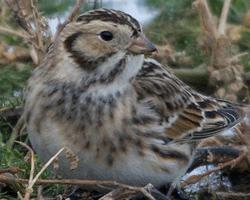
Váhy a míry
| Délka | od 15 do 16 cm |
|---|---|
| Hmotnost | od 17 do 20 g |
| Délka rozpětí křídel | od 21 do 28 cm |
Stav ohrožení
| Ohrožen |
Popis zvířete
The Common Reed Bunting, scientifically named Emberiza schoeniclus, is a passerine bird belonging to the bunting family Emberizidae. This bird species is particularly notable for its distinctive plumage and the unique habitats it frequents, primarily across Europe and much of temperate and northern Asia. The bird is a symbol of the intricate beauty found within marshy landscapes and reedbeds, which are its preferred breeding grounds.Physical Description:
The Common Reed Bunting exhibits sexual dimorphism, meaning males and females have distinctly different appearances, especially during the breeding season. The male, in his breeding plumage, boasts a striking black head, white collar, and a mottled brown back, with dashes of black and white interspersed throughout. Its underparts are a pale grey or white. This bold patterning serves both as a display during mating rituals and as a form of camouflage within the reeds. Outside the breeding season, the male's plumage becomes more subdued, resembling that of the female, which is primarily a blend of browns and buffs, designed to blend seamlessly into the bird's reedbed habitat. Both sexes have a conical seed-eater's bill, adapted for their diet, and display a characteristic white outer tail feather during flight.
Habitat and Distribution:
The Common Reed Bunting is predominantly found in wetland habitats, including reed beds, marshes, and lakesides. These environments provide not only the dense vegetation required for nesting but also a steady diet of seeds and insects. The bird's range extends from western Europe across the Palearctic to central Siberia. It is a migratory species, with many birds wintering in southern Europe and southern Asia, though some populations in the milder western parts of its range are resident year-round.
Behavior and Diet:
Primarily granivorous, the Common Reed Bunting adapts its diet according to availability, consuming a variety of seeds from grasses and reeds. During the breeding season, it also feeds on insects, which are a crucial source of protein for the growing chicks. The bird's foraging behavior is predominantly ground-based, although it will also pick seeds directly from plants.
Reproduction:
The breeding season of the Common Reed Bunting begins in spring. The nest is artfully concealed among reeds or in dense undergrowth, meticulously constructed by the female using grasses and lined with finer materials. The female typically lays between 3 to 5 eggs, which she incubates for about 12 to 14 days. Both parents are involved in feeding the altricial (helpless) chicks, which fledge approximately 10-14 days after hatching.
Conservation Status:
The Common Reed Bunting is classified as Least Concern by the International Union for Conservation of Nature (IUCN), thanks to its wide distribution and large population. However, like many species dependent on wetland habitats, it faces threats from habitat destruction and degradation, particularly due to drainage of wetlands, agricultural expansion, and urban development. Conservation efforts aimed at preserving and restoring wetland habitats are crucial for the continued survival of this species.
In conclusion, the Common Reed Bunting is a fascinating bird species, emblematic of the rich biodiversity found within wetland ecosystems. Its presence and survival are intricately linked to the health of these habitats, making it an important species for conservation efforts aimed at preserving the natural heritage of our planet.
Podobná zvířata
Nové fotografie zvířat
Top 10 zvířat
- Dolphin gull (Leucophaeus scoresbii)
- Diana monkey (Cercopithecus diana)
- Moustached guenon (Cercopithecus cephus)
- Galápagos tortoise (Geochelone nigra complex)
- Russian tortoise (Testudo horsfieldii)
- Japanese macaque (Macaca fuscata)
- Stone loach (Barbatula barbatula)
- Greek tortoise (Testudo graeca)
- Common flying dragon (Draco volans)
- Colossal squid (Mesonychoteuthis hamiltoni)


